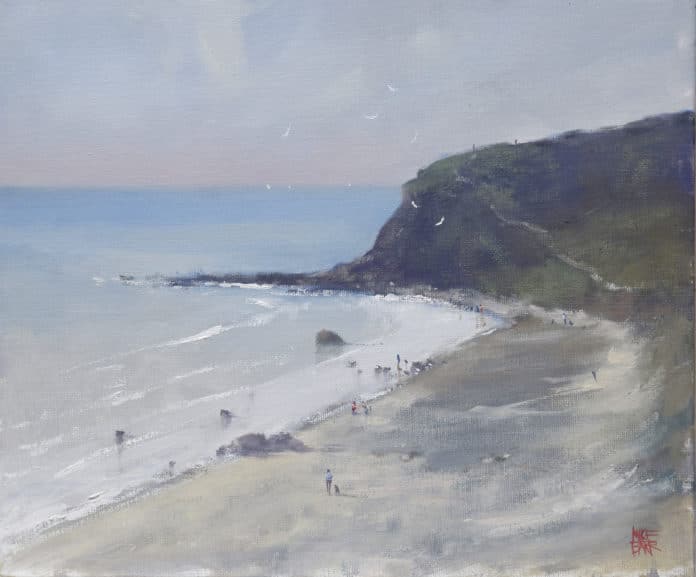
How to paint beaches > The key to an effective plein air beach scene is to keep it simple — and that goes for your equipment, your palette, and your subject.
How to Paint Beaches: Nail the Illusion of Distance, Light, and Atmosphere
By Mike Barr
Even though I resisted it at first, the move to plein air seascapes from studio work was a natural one for me. In the studio, I painted quickly, mainly because of the time constraints of holding down a full-time job. It meant every minute at the easel counted and there was no time for intricate work. Also, I had a thing for beachscapes; they seemed simpler to deal with than complex landscapes, and I loved the coast’s feeling of grandeur.
I’ve painted hundreds of “simple” works and gained valuable assets in my painting career — namely speed, skill, and confidence. These qualities provided a great basis for my plein air work, and, in turn, I’ve found that plein air painting has helped me further develop all three.
THREE QUALITIES CRUCIAL TO PLEIN AIR PAINTING
Plein air is the anvil upon which the qualities of a good artist are hammered out.
Forced to paint with relative speed, you learn to look at the big shapes, broad tones, and aerial perspective. Painting outdoors also prevents you from getting bogged down in non-essential details. There’s nothing more frustrating than spending an hour on one object when the whole painting could be finished in the same amount of time.
Skill builds speed, and there’s no substitute for time spent in the field — making mistakes, recognizing them, and learning from them — to grow in both.
With confidence, you can wield a broad brush and leave brushstrokes untouched. Speed and skill boost confidence, which in turn increases your speed and skill. What a wonderful cycle this is!
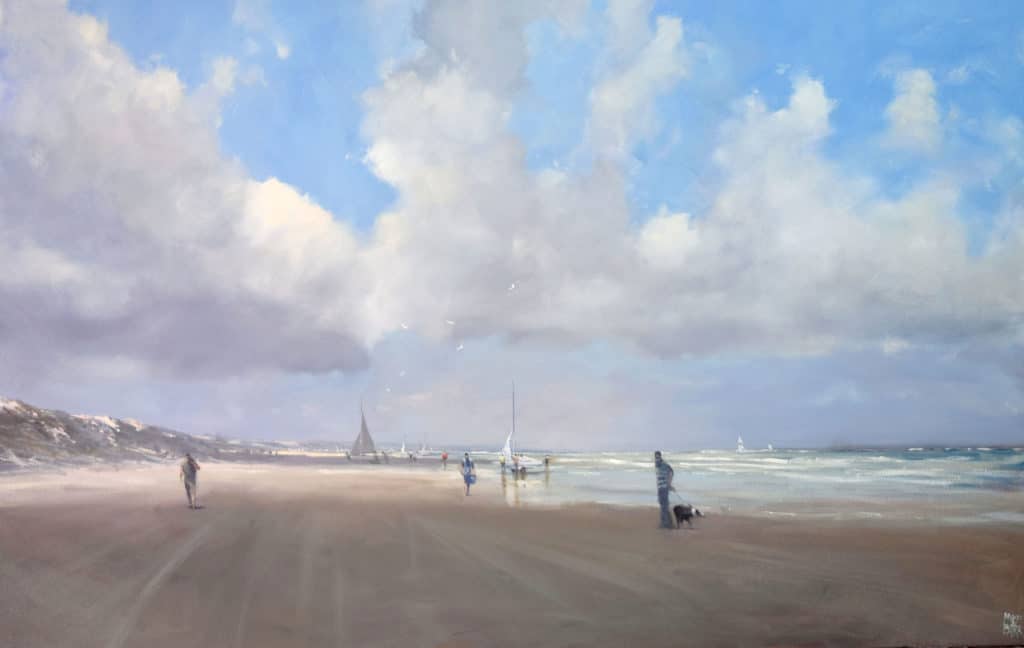
Goolwa Beach is truly magnificent, but there is no sailing club there or yachts. Still, I really wanted the additional elements to add to the drama already created by the clouds and their shadows on the beach. I believe that we can’t let visual truth get in the way of an interesting subject. As artists, it’s our prerogative to change things as we see fit.
KEYS TO KEEPING IT SIMPLE
Like any plein air work, a beachscape requires the key of simplicity to unlock its wonders.
Simplifying the subject is a skill in itself and will come with practice. Often, we need to disregard the whole scene and focus on one small part, even if it’s in the distance. While beaches and seascapes may seem simple enough, it’s easy to be roped in by waves, ripples, and other features that get more complex the more you look at them.
Simplifying your palette is also important. Not only will it make your set-up time go faster and reduce the amount of material you take outdoors, it will improve your color-mixing skills like nothing else. With time and practice, you’ll come to know intuitively what colors to mix to get what you want, instead of searching the manufacturer’s color chart.
To me, the atmosphere of the beach is the all-important focus. Let the photographer document the detail; I’ll capture the essence of the place by enhancing what’s already there. The plein air impressionist’s job is a wonderful one, and it doesn’t mean copying the scene; it means capturing the day.
6 TIPS FOR PAINTING BEACHSCAPES EN PLEIN AIR
1. Always make sure the horizon is level. No matter how brilliant the rest of the painting is, if the horizon isn’t level, all viewers will notice.
2. Don’t be afraid of leaving awkward stuff out. Remember, we are totally in charge of our paintings.
3. Exaggerate the lights, the darks, and anything else you think is important.
4. The actual scene may not have sails, people, or birds in it, but consider adding them to enhance the feeling of distance, expanse, and interest.
5. Say hello to bystanders. You never know where an interaction may lead. If you’re grumpy, your reputation will follow you.
6. Keep things simple, and that includes your subject, palette, and equipment.
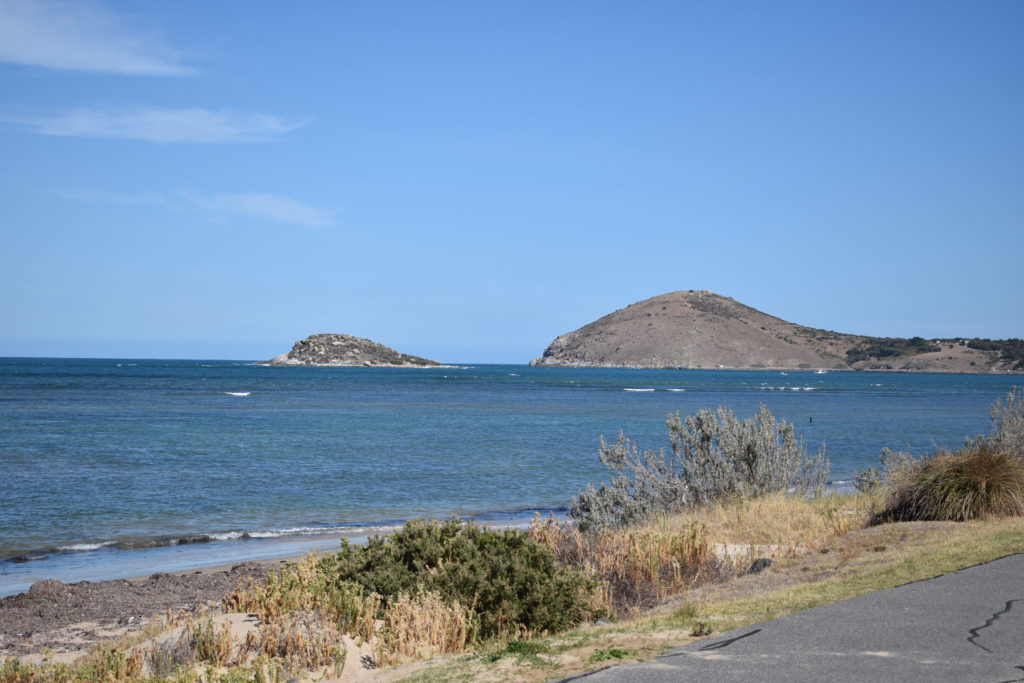
How to Paint Beaches
BEACH PAINTING DEMONSTRATION: Creating a Sense of Scale and Volume
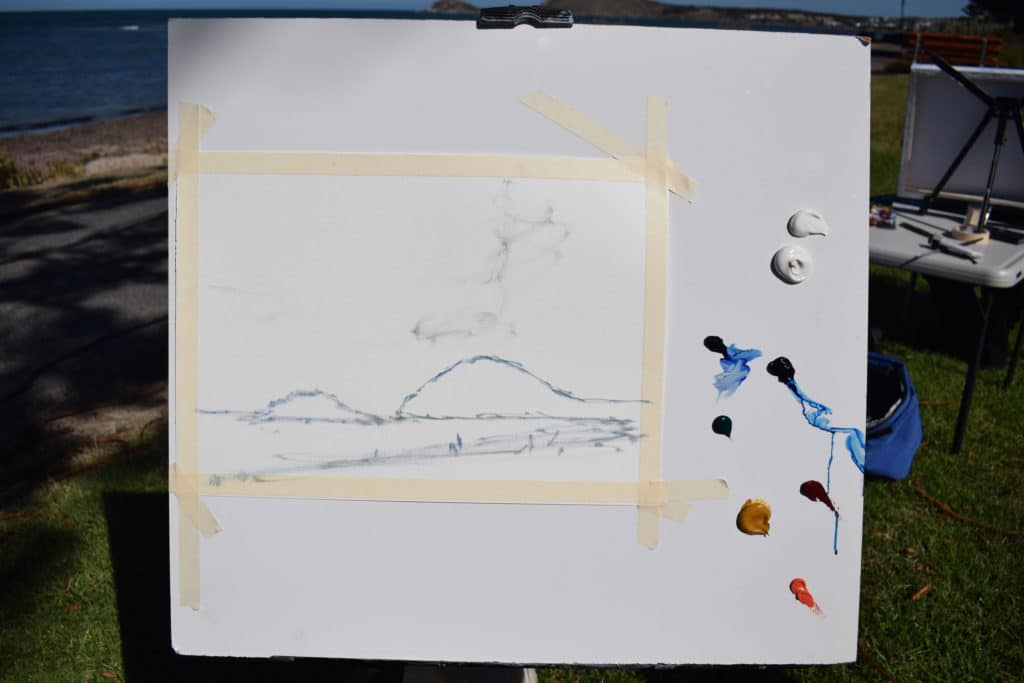
Step 1: I tape a sheet of Canson oil painting paper onto melamine-coated MDF board.
For ease of access, I squeeze out my colors directly onto the MDF board (see “My Palette” below for details), right next to my painting. I then begin to establish the main shapes with a light wash. I avoid using pencil because if I use it, I’m forever looking for the lines, and it tightens up the painting. As you can see by comparing this stage to the photograph, I’m portraying the bluff bigger than it actually is, but I leave it as-is because the exaggeration suits the imposing land mass. There is so much to see, but I focused on the bluff and island and left out the shrubbery near the shore and the path. I never let the scene dictate too much what goes into the painting.
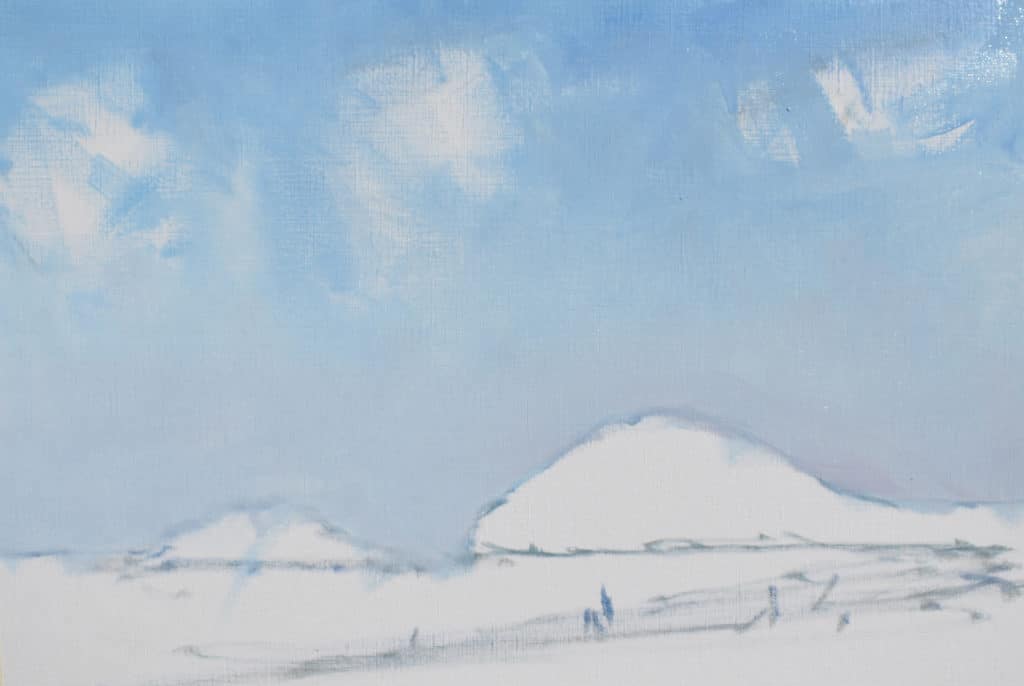
Step 2: A big sky features in all of my sea and beach scenes, providing volume and depth that will set up the rest of the painting. I imply distance by painting dark at the top and progressively lighter as I move toward the horizon. Right on the horizon, I add either a pink or purple; this little band of subdued color will give the sky the aerial perspective it needs. I nearly always add clouds, even if they’re not really there. Clouds add volume to the sky and create the illusion of space that you feel so distinctly when on the shore.
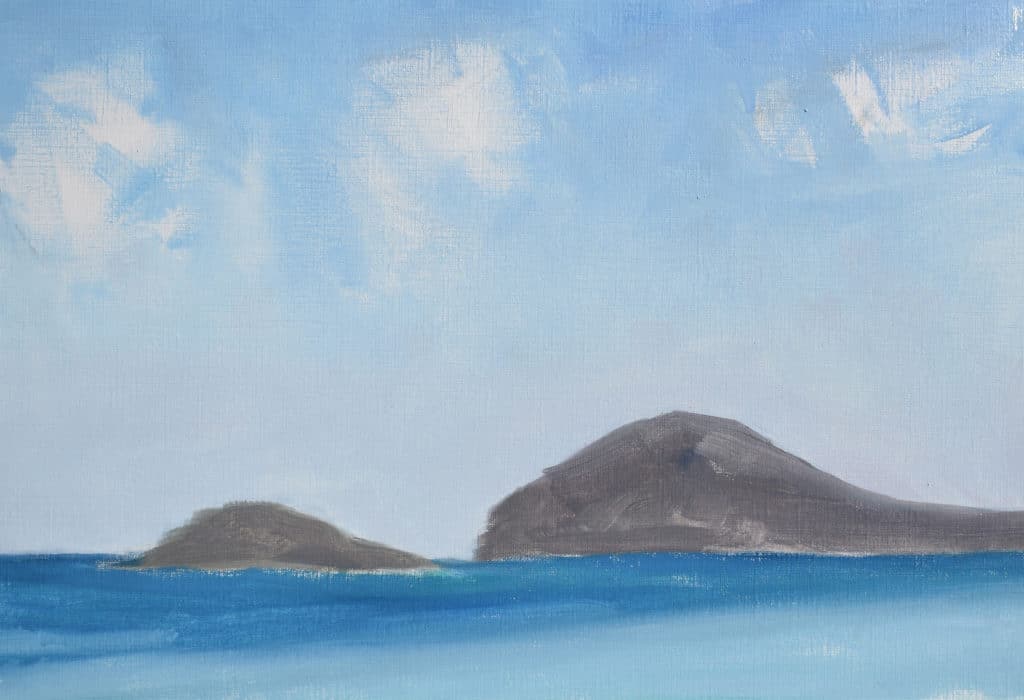
Step 3: Everything is now blocked in and looking rather awkward, but the best is yet to come. Once these base colors are down, the really enjoyable part can begin. As you can see, I have made the sea more blue-green than it appears in the photo. In the summer months, the aqua greens are something to behold in and around Victor Harbor in South Australia.
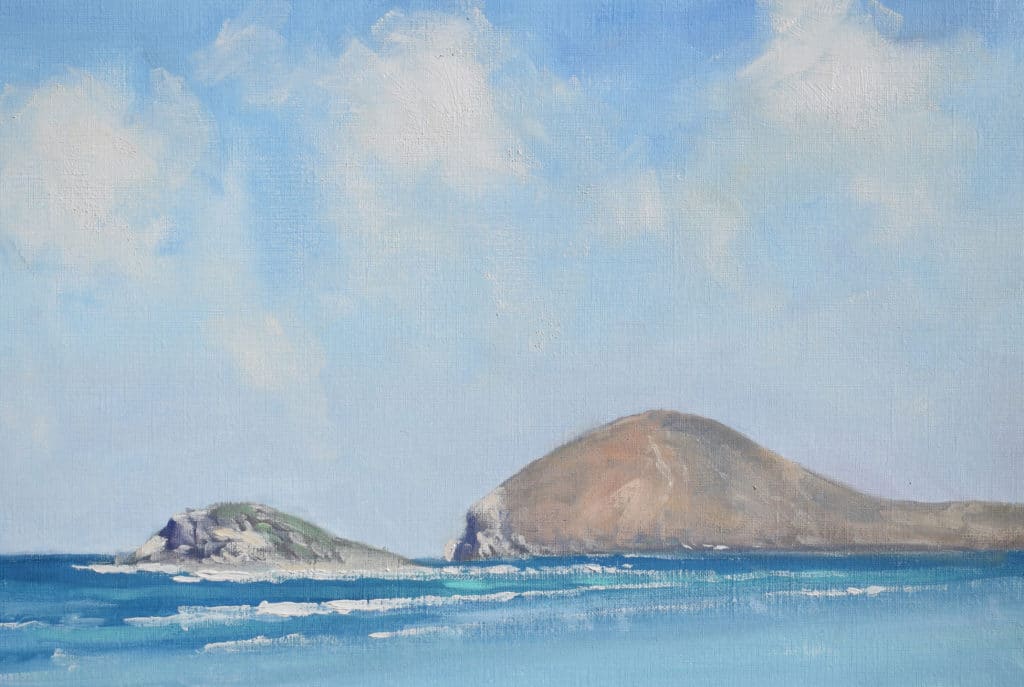
Step 4: I boldly whisk in the wispy clouds with white and a tiny amount of yellow ochre. Being a bit bold with the brush in the sky gives the painting a feeling of energy. Getting too finicky with a small brush in the clouds can constipate the whole scene. The land forms have to be given some volume as well, and the most important elements in the whole painting are the two dark shadows on the island and the bluff. These shadows make the lights shine, both in the sky and the sea. You will also notice a subtle difference in the shadows, with the one on the island just a bit darker than the one on the bluff. This sets the bluff back a bit. The waves are just brushstrokes of pure white. The painting is coming to life.
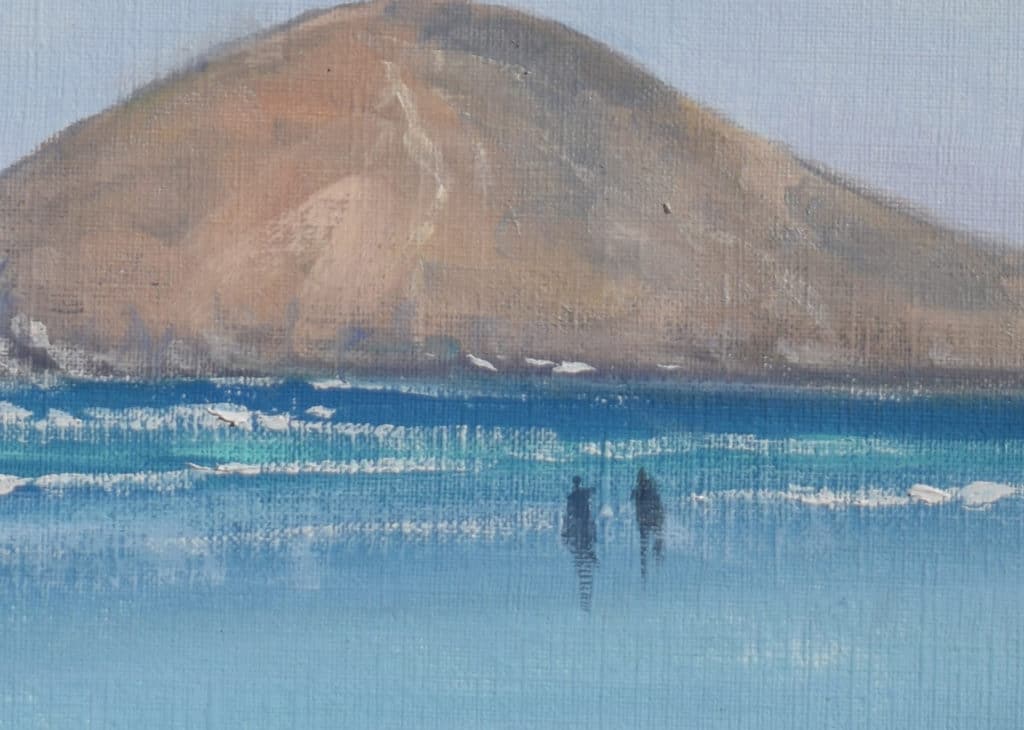
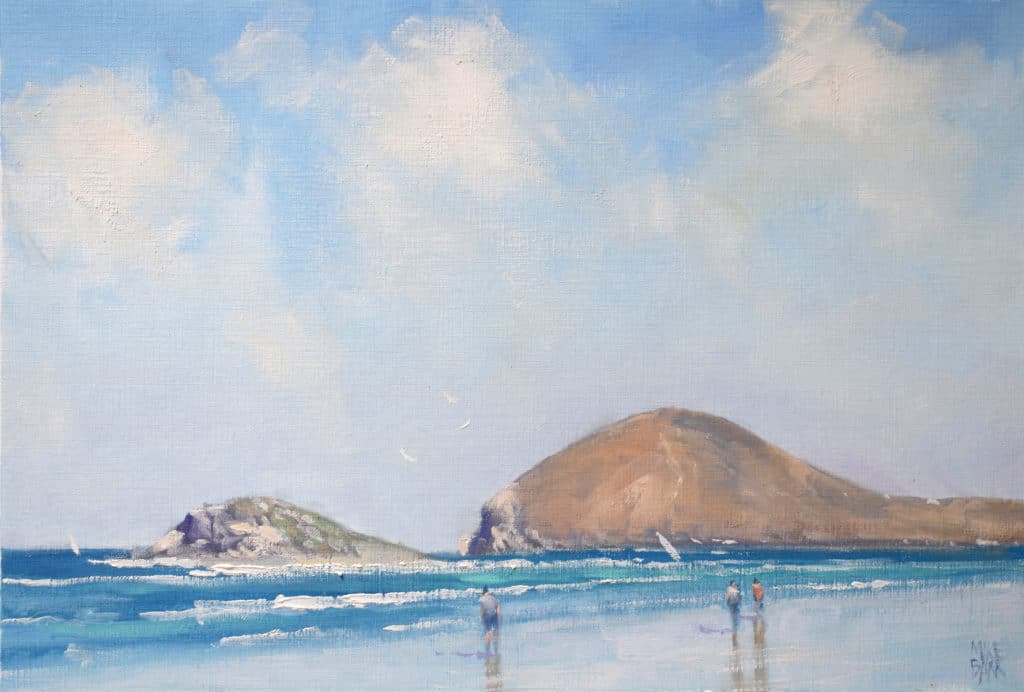
Final Step: For me, a beach scene is nothing without people, so I almost always add them. As well as giving the painting some scale, figures also add human interest and identification; to do so, they need only to be simple suggestions, not full-scale portraits. I also lighten up the shallows, which gives the work more light. I never miss putting in a few seagulls; while many may think this is quaint, they serve an important function in the painting. Birds in flight give the sky even more volume. It is such a simple thing, but it works. Yachts may fall under the same category of cuteness and predictability, but they are so good at being a mid-distance object.
MY PALETTE
As you can see, I limit my colors (Archival Oils) severely. I have two blues (although I could have managed with one) — phthalo blue (red shade) and ultramarine, which produces some important shadow darks in conjunction with alizarin, another color on my palette. Phthalo green (or viridian) is essential for making those sunny aqua greens in the sea. Yellow ochre is generally the only yellow I use; the bright yellows just seem too bold, unless I’m using them as a special highlight. I also use quick-drying white. To thin the paint and clean my brushes, I use Archival Oils Odourless Solvent.
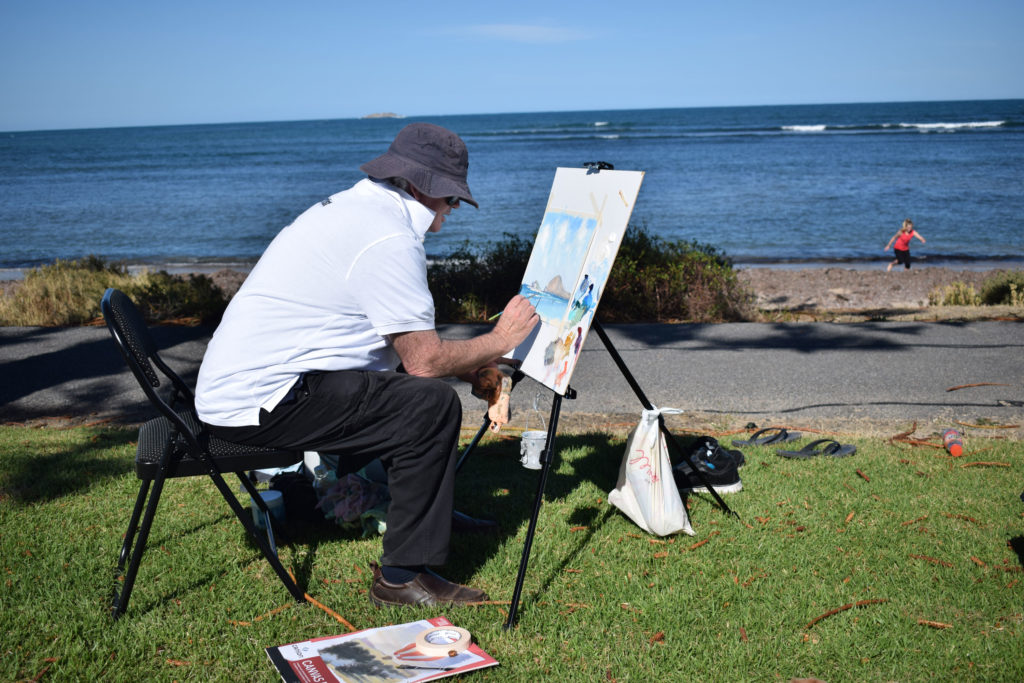
About the Artist:
Mike Barr (mikebarrfineart.com) lives in Adelaide, South Australia, where he’s drawn to the real-life drama of rainy day street scenes and beachscapes.
Visit EricRhoads.com to find out all the amazing opportunities for artists through Streamline Publishing, including:
– Online art conferences such as Plein Air Live
– New video workshops for artists
– Incredible art retreats, such as painting in New Zealand!
– Educational and fun art conventions, and much more.
> Subscribe to Plein Air Today, a free newsletter for artists
> Subscribe to PleinAir Magazine so you never miss an issue





Wonderful advice! Thanks for sharing!